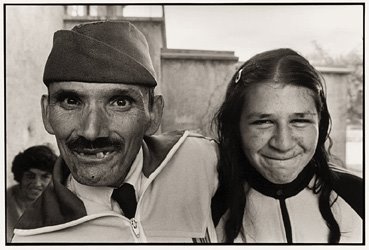 The Chilean Paz Errázuriz is one of my favourite photographers. She works in black and white, and in series, producing primarily portraits of figures who are in one way or another marginal: working class boxers; carnival artistes; street people; transvestites; the institutionalized; the indigenous.
The Chilean Paz Errázuriz is one of my favourite photographers. She works in black and white, and in series, producing primarily portraits of figures who are in one way or another marginal: working class boxers; carnival artistes; street people; transvestites; the institutionalized; the indigenous. I've just got hold of Paz Errázuriz: Photography / Fotografía 1983-2002, the catalogue from a major retrospective exhibition held in Santiago a couple of years ago. Looking back over twenty years of her work, what emerges is how much Errázuriz is a photographer of affect. She records bodies marked by their encounters with the world, with other bodies. And from these states of affection, she extracts also the abstract affects that surround such bodies, what Deleuze terms "veritable critical entities that hover over the body and judge it" (Essays Critical and Clinical 124).
It is by drawing on the power of affect that these subalternized non-subjects, excluded from conventional discourse, express and construct their individuality--an individuality that may, as in the series El infarto del alma, only be constituted through a couple, through a mutual becoming and doubling.
El infarto del alma (Heart Attack of the Soul) consists of photos of couples that have formed within the confines of the Putaendo psychiatric hospital, a state facility for the destitute deranged. What Errázuriz (and Diamela Eltit, the writer who worked with her on this project) found here was far from the "bare life" of psychotic degradation and institutional repression that one might expect. Rather, she uncovers affective intensities, and the powerful assertion of new individualities.

Or in Nelly Richard's words, from the essay that is her contribution to the catalogue:
Identities disarmed by psychotic fragmentation or amorous revolt are restructured in the pose that enforces a synthesis of their disconnected corporealities. Despite the multiple deliria expressed in the intermittent and startled language of the nervous tick, these corporealities manage to regain agency, in a relative synchronicity of gestures and postures, by means of a pose that enunciates, also, the complex ritual of the human couple through the amatory figures of embrace and caress. (21; translation modified)Fragmented non-organic bodies, composed of gestures and postures, states of bodily affection, come together to constitute new forms of subjectivity captured by, but also facing down, Errázuriz's camera.
Back to Deleuze:
Affective critical entities do not cancel each other out, but can coexist and intermingle, composing the character of the mind, constituting not an ego but a center of gravity that is displaced from one entity to the next, following the secret threads of this marionette theater. Perhaps this is what glory is: a hidden will that makes entities communicate, and extracts them at the favorable moment. (124)Errázuriz's photography is, in this sense, glorious.
No comments:
Post a Comment